Taxation Law Assignment: Case Study Analysis and Taxation Principles
VerifiedAdded on 2021/06/15
|11
|3660
|26
Homework Assignment
AI Summary
This assignment delves into the intricacies of taxation law, primarily through the analysis of two case studies: Arthur Murray (NSW) Pty Ltd v FCT (1965) and a hypothetical case involving RIP Pty Ltd. The assignment explores key concepts such as assessable income, the application of the ITAA 1997, and the distinction between earnings and receipt methods of accounting for income. It examines how prepaid fees are treated for tax purposes, considering whether they constitute income at the time of receipt or when services are rendered. The assignment also addresses the treatment of trading inventory, capital assets, and allowable deductions, providing a comprehensive overview of relevant taxation principles. The student analyzes the implications of forfeited payments and the tax treatment of funeral-related services, offering a practical application of taxation rules. The assignment demonstrates an understanding of the legal and accounting aspects of taxation, providing insights into the application of these principles in real-world scenarios.
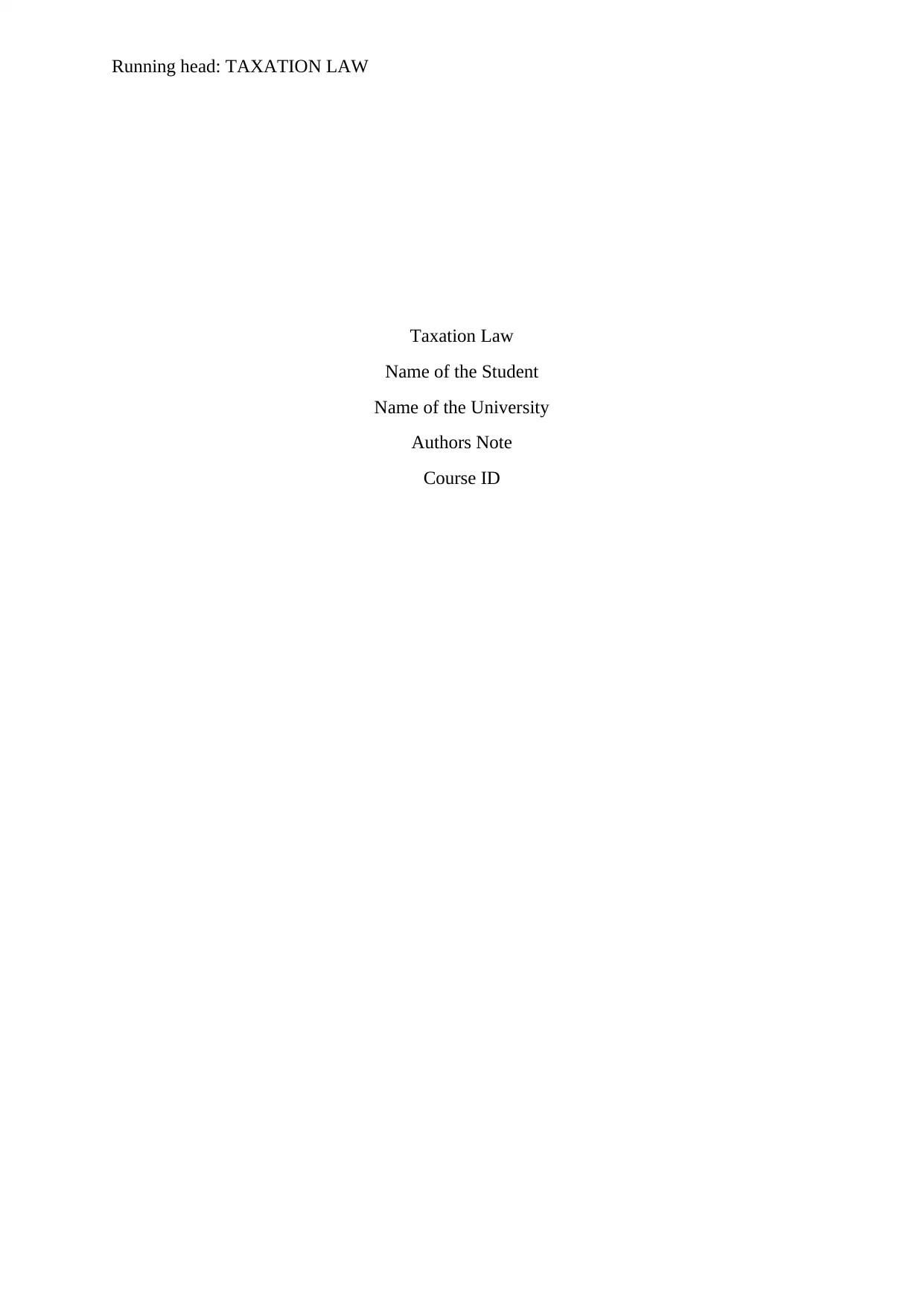
Running head: TAXATION LAW
Taxation Law
Name of the Student
Name of the University
Authors Note
Course ID
Taxation Law
Name of the Student
Name of the University
Authors Note
Course ID
Paraphrase This Document
Need a fresh take? Get an instant paraphrase of this document with our AI Paraphraser
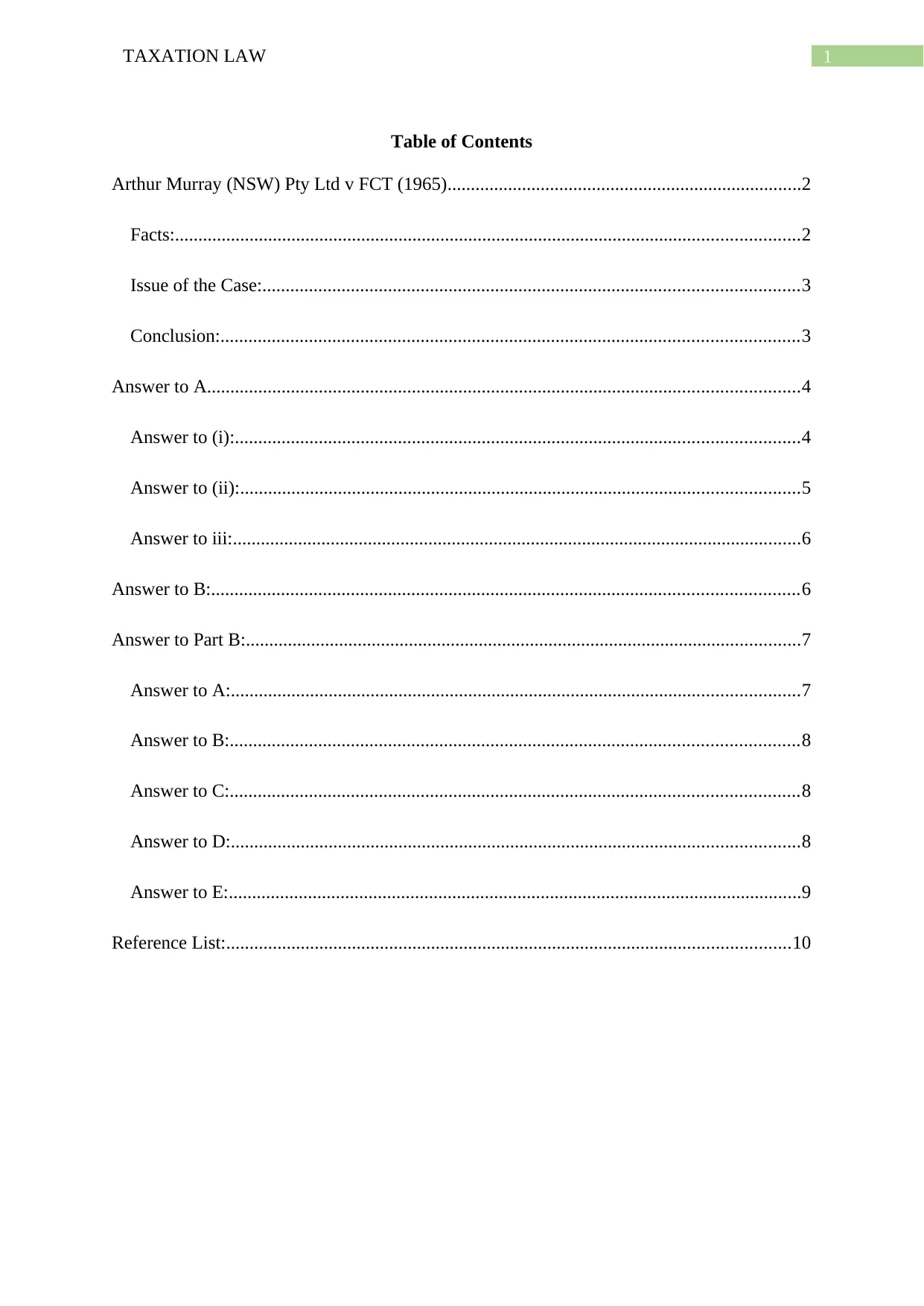
1TAXATION LAW
Table of Contents
Arthur Murray (NSW) Pty Ltd v FCT (1965)............................................................................2
Facts:......................................................................................................................................2
Issue of the Case:...................................................................................................................3
Conclusion:............................................................................................................................3
Answer to A...............................................................................................................................4
Answer to (i):.........................................................................................................................4
Answer to (ii):........................................................................................................................5
Answer to iii:..........................................................................................................................6
Answer to B:..............................................................................................................................6
Answer to Part B:.......................................................................................................................7
Answer to A:..........................................................................................................................7
Answer to B:..........................................................................................................................8
Answer to C:..........................................................................................................................8
Answer to D:..........................................................................................................................8
Answer to E:...........................................................................................................................9
Reference List:.........................................................................................................................10
Table of Contents
Arthur Murray (NSW) Pty Ltd v FCT (1965)............................................................................2
Facts:......................................................................................................................................2
Issue of the Case:...................................................................................................................3
Conclusion:............................................................................................................................3
Answer to A...............................................................................................................................4
Answer to (i):.........................................................................................................................4
Answer to (ii):........................................................................................................................5
Answer to iii:..........................................................................................................................6
Answer to B:..............................................................................................................................6
Answer to Part B:.......................................................................................................................7
Answer to A:..........................................................................................................................7
Answer to B:..........................................................................................................................8
Answer to C:..........................................................................................................................8
Answer to D:..........................................................................................................................8
Answer to E:...........................................................................................................................9
Reference List:.........................................................................................................................10
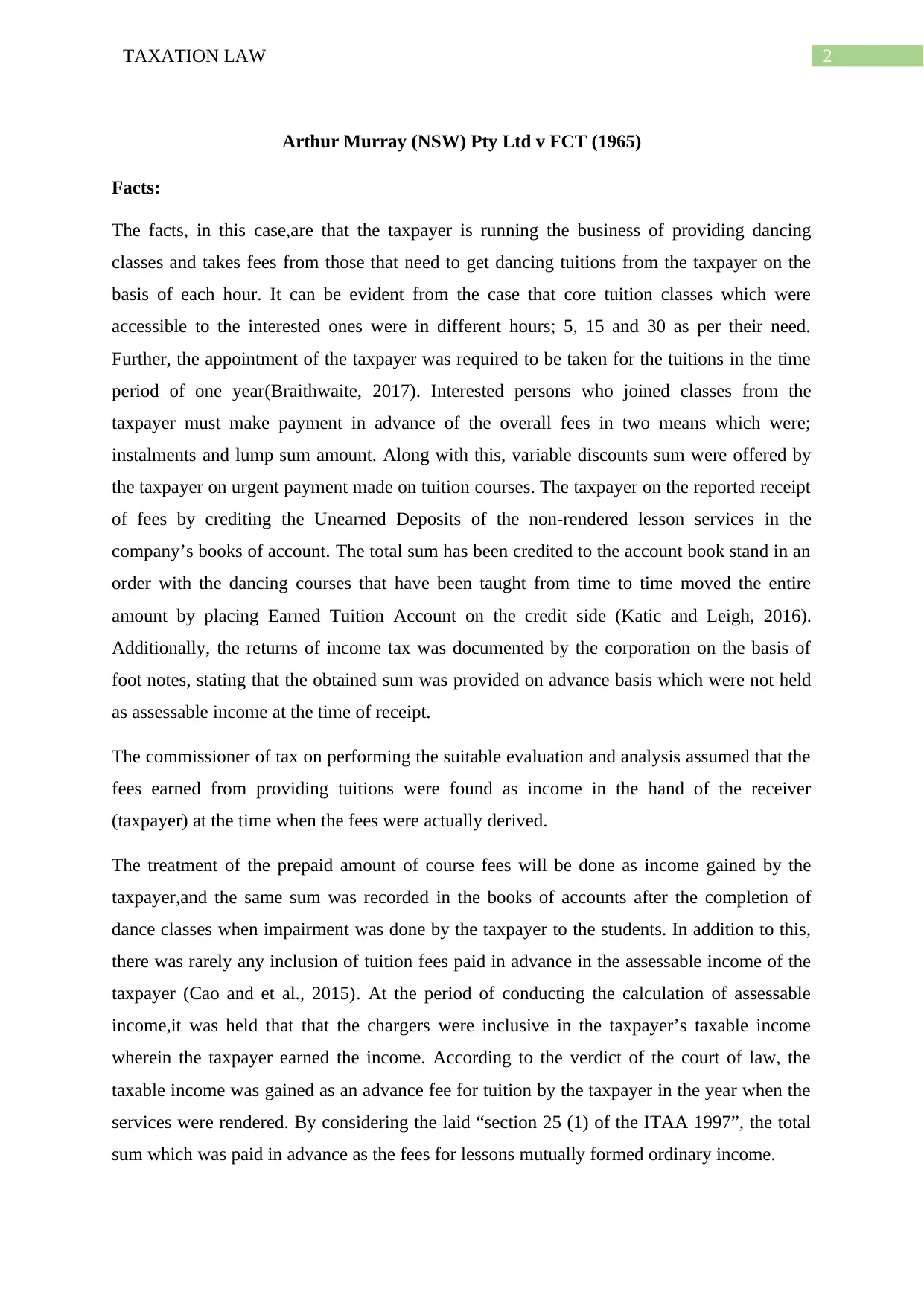
2TAXATION LAW
Arthur Murray (NSW) Pty Ltd v FCT (1965)
Facts:
The facts, in this case,are that the taxpayer is running the business of providing dancing
classes and takes fees from those that need to get dancing tuitions from the taxpayer on the
basis of each hour. It can be evident from the case that core tuition classes which were
accessible to the interested ones were in different hours; 5, 15 and 30 as per their need.
Further, the appointment of the taxpayer was required to be taken for the tuitions in the time
period of one year(Braithwaite, 2017). Interested persons who joined classes from the
taxpayer must make payment in advance of the overall fees in two means which were;
instalments and lump sum amount. Along with this, variable discounts sum were offered by
the taxpayer on urgent payment made on tuition courses. The taxpayer on the reported receipt
of fees by crediting the Unearned Deposits of the non-rendered lesson services in the
company’s books of account. The total sum has been credited to the account book stand in an
order with the dancing courses that have been taught from time to time moved the entire
amount by placing Earned Tuition Account on the credit side (Katic and Leigh, 2016).
Additionally, the returns of income tax was documented by the corporation on the basis of
foot notes, stating that the obtained sum was provided on advance basis which were not held
as assessable income at the time of receipt.
The commissioner of tax on performing the suitable evaluation and analysis assumed that the
fees earned from providing tuitions were found as income in the hand of the receiver
(taxpayer) at the time when the fees were actually derived.
The treatment of the prepaid amount of course fees will be done as income gained by the
taxpayer,and the same sum was recorded in the books of accounts after the completion of
dance classes when impairment was done by the taxpayer to the students. In addition to this,
there was rarely any inclusion of tuition fees paid in advance in the assessable income of the
taxpayer (Cao and et al., 2015). At the period of conducting the calculation of assessable
income,it was held that that the chargers were inclusive in the taxpayer’s taxable income
wherein the taxpayer earned the income. According to the verdict of the court of law, the
taxable income was gained as an advance fee for tuition by the taxpayer in the year when the
services were rendered. By considering the laid “section 25 (1) of the ITAA 1997”, the total
sum which was paid in advance as the fees for lessons mutually formed ordinary income.
Arthur Murray (NSW) Pty Ltd v FCT (1965)
Facts:
The facts, in this case,are that the taxpayer is running the business of providing dancing
classes and takes fees from those that need to get dancing tuitions from the taxpayer on the
basis of each hour. It can be evident from the case that core tuition classes which were
accessible to the interested ones were in different hours; 5, 15 and 30 as per their need.
Further, the appointment of the taxpayer was required to be taken for the tuitions in the time
period of one year(Braithwaite, 2017). Interested persons who joined classes from the
taxpayer must make payment in advance of the overall fees in two means which were;
instalments and lump sum amount. Along with this, variable discounts sum were offered by
the taxpayer on urgent payment made on tuition courses. The taxpayer on the reported receipt
of fees by crediting the Unearned Deposits of the non-rendered lesson services in the
company’s books of account. The total sum has been credited to the account book stand in an
order with the dancing courses that have been taught from time to time moved the entire
amount by placing Earned Tuition Account on the credit side (Katic and Leigh, 2016).
Additionally, the returns of income tax was documented by the corporation on the basis of
foot notes, stating that the obtained sum was provided on advance basis which were not held
as assessable income at the time of receipt.
The commissioner of tax on performing the suitable evaluation and analysis assumed that the
fees earned from providing tuitions were found as income in the hand of the receiver
(taxpayer) at the time when the fees were actually derived.
The treatment of the prepaid amount of course fees will be done as income gained by the
taxpayer,and the same sum was recorded in the books of accounts after the completion of
dance classes when impairment was done by the taxpayer to the students. In addition to this,
there was rarely any inclusion of tuition fees paid in advance in the assessable income of the
taxpayer (Cao and et al., 2015). At the period of conducting the calculation of assessable
income,it was held that that the chargers were inclusive in the taxpayer’s taxable income
wherein the taxpayer earned the income. According to the verdict of the court of law, the
taxable income was gained as an advance fee for tuition by the taxpayer in the year when the
services were rendered. By considering the laid “section 25 (1) of the ITAA 1997”, the total
sum which was paid in advance as the fees for lessons mutually formed ordinary income.
⊘ This is a preview!⊘
Do you want full access?
Subscribe today to unlock all pages.

Trusted by 1+ million students worldwide
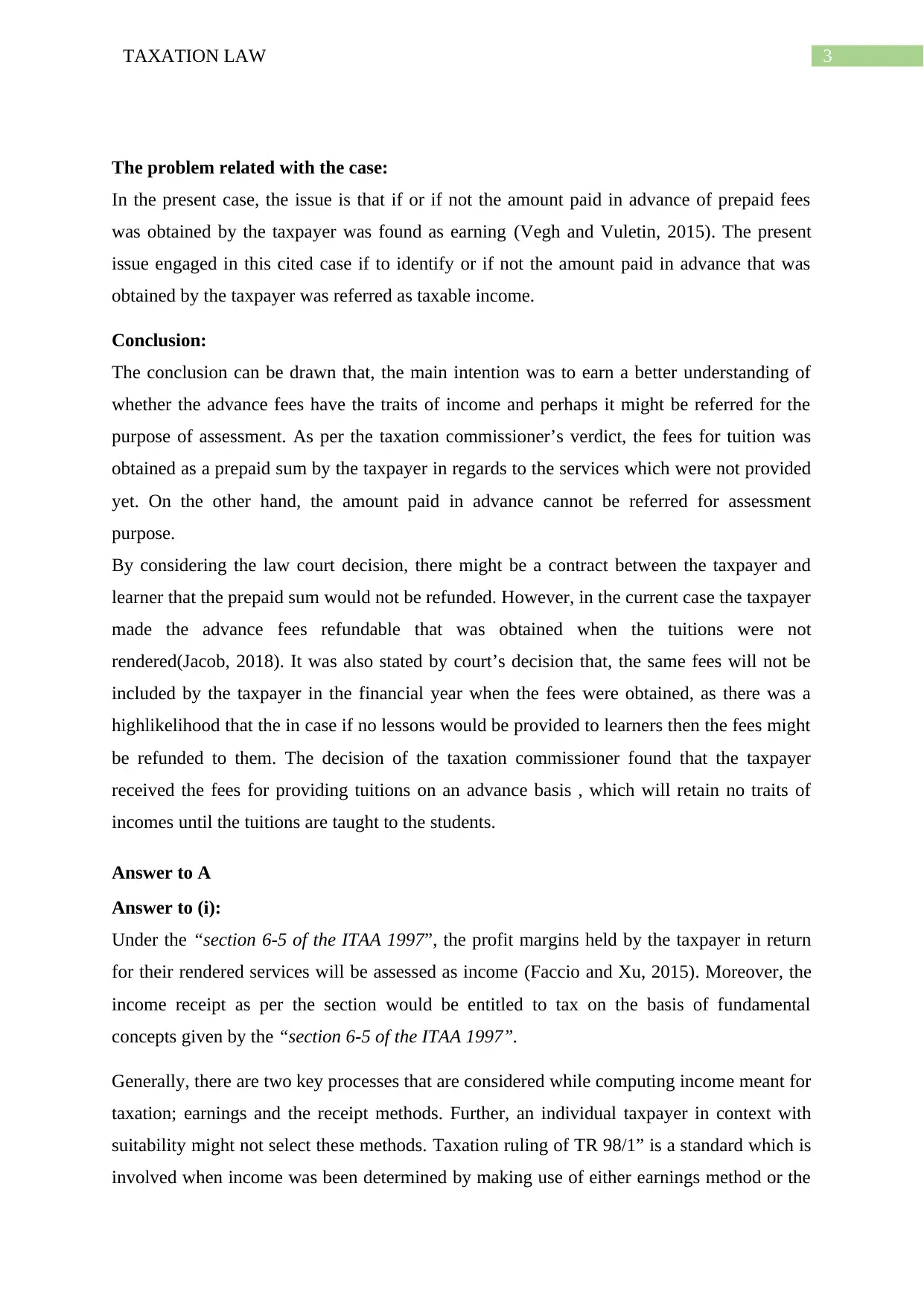
3TAXATION LAW
The problem related with the case:
In the present case, the issue is that if or if not the amount paid in advance of prepaid fees
was obtained by the taxpayer was found as earning (Vegh and Vuletin, 2015). The present
issue engaged in this cited case if to identify or if not the amount paid in advance that was
obtained by the taxpayer was referred as taxable income.
Conclusion:
The conclusion can be drawn that, the main intention was to earn a better understanding of
whether the advance fees have the traits of income and perhaps it might be referred for the
purpose of assessment. As per the taxation commissioner’s verdict, the fees for tuition was
obtained as a prepaid sum by the taxpayer in regards to the services which were not provided
yet. On the other hand, the amount paid in advance cannot be referred for assessment
purpose.
By considering the law court decision, there might be a contract between the taxpayer and
learner that the prepaid sum would not be refunded. However, in the current case the taxpayer
made the advance fees refundable that was obtained when the tuitions were not
rendered(Jacob, 2018). It was also stated by court’s decision that, the same fees will not be
included by the taxpayer in the financial year when the fees were obtained, as there was a
highlikelihood that the in case if no lessons would be provided to learners then the fees might
be refunded to them. The decision of the taxation commissioner found that the taxpayer
received the fees for providing tuitions on an advance basis , which will retain no traits of
incomes until the tuitions are taught to the students.
Answer to A
Answer to (i):
Under the “section 6-5 of the ITAA 1997”, the profit margins held by the taxpayer in return
for their rendered services will be assessed as income (Faccio and Xu, 2015). Moreover, the
income receipt as per the section would be entitled to tax on the basis of fundamental
concepts given by the “section 6-5 of the ITAA 1997”.
Generally, there are two key processes that are considered while computing income meant for
taxation; earnings and the receipt methods. Further, an individual taxpayer in context with
suitability might not select these methods. Taxation ruling of TR 98/1” is a standard which is
involved when income was been determined by making use of either earnings method or the
The problem related with the case:
In the present case, the issue is that if or if not the amount paid in advance of prepaid fees
was obtained by the taxpayer was found as earning (Vegh and Vuletin, 2015). The present
issue engaged in this cited case if to identify or if not the amount paid in advance that was
obtained by the taxpayer was referred as taxable income.
Conclusion:
The conclusion can be drawn that, the main intention was to earn a better understanding of
whether the advance fees have the traits of income and perhaps it might be referred for the
purpose of assessment. As per the taxation commissioner’s verdict, the fees for tuition was
obtained as a prepaid sum by the taxpayer in regards to the services which were not provided
yet. On the other hand, the amount paid in advance cannot be referred for assessment
purpose.
By considering the law court decision, there might be a contract between the taxpayer and
learner that the prepaid sum would not be refunded. However, in the current case the taxpayer
made the advance fees refundable that was obtained when the tuitions were not
rendered(Jacob, 2018). It was also stated by court’s decision that, the same fees will not be
included by the taxpayer in the financial year when the fees were obtained, as there was a
highlikelihood that the in case if no lessons would be provided to learners then the fees might
be refunded to them. The decision of the taxation commissioner found that the taxpayer
received the fees for providing tuitions on an advance basis , which will retain no traits of
incomes until the tuitions are taught to the students.
Answer to A
Answer to (i):
Under the “section 6-5 of the ITAA 1997”, the profit margins held by the taxpayer in return
for their rendered services will be assessed as income (Faccio and Xu, 2015). Moreover, the
income receipt as per the section would be entitled to tax on the basis of fundamental
concepts given by the “section 6-5 of the ITAA 1997”.
Generally, there are two key processes that are considered while computing income meant for
taxation; earnings and the receipt methods. Further, an individual taxpayer in context with
suitability might not select these methods. Taxation ruling of TR 98/1” is a standard which is
involved when income was been determined by making use of either earnings method or the
Paraphrase This Document
Need a fresh take? Get an instant paraphrase of this document with our AI Paraphraser
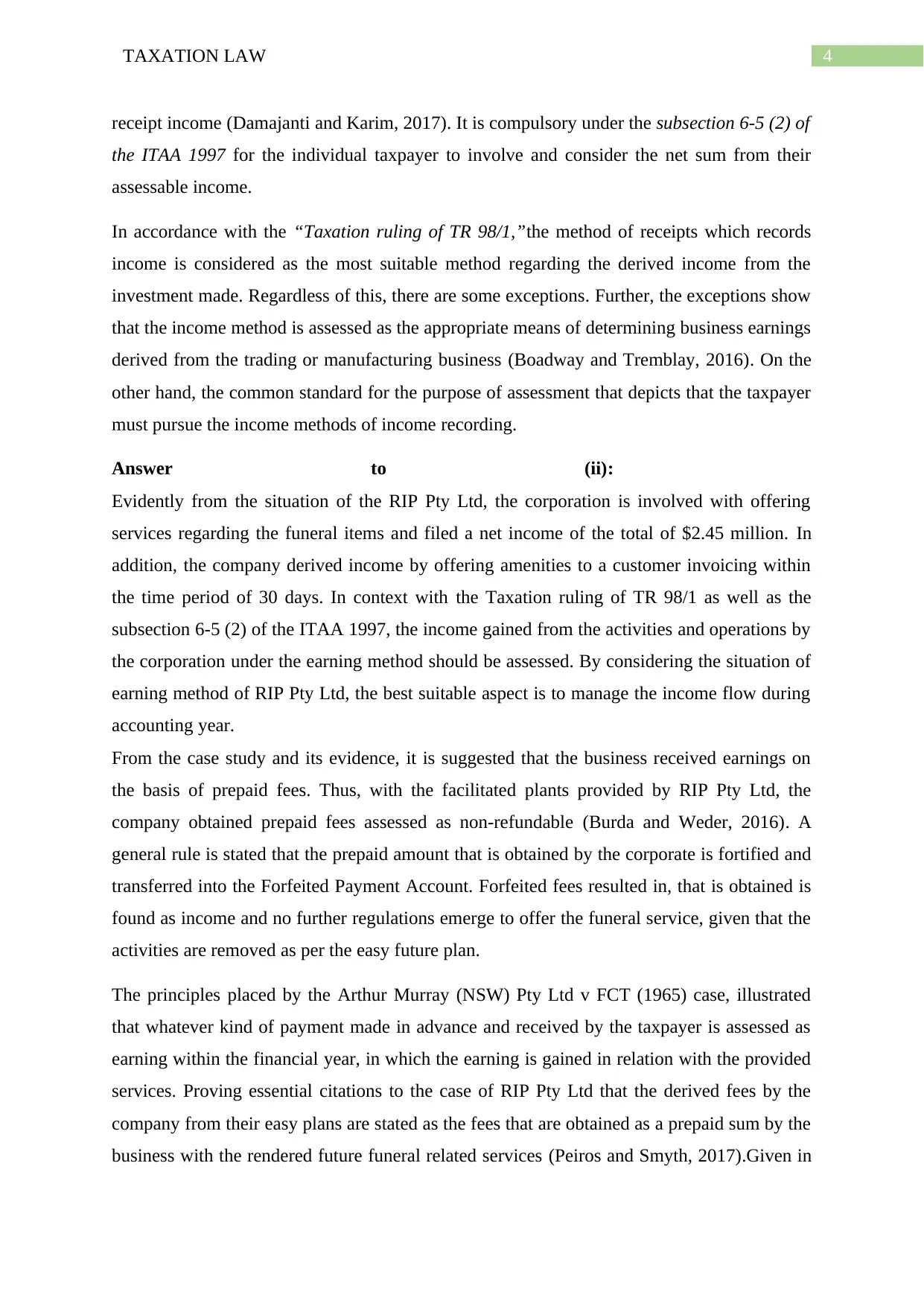
4TAXATION LAW
receipt income (Damajanti and Karim, 2017). It is compulsory under the subsection 6-5 (2) of
the ITAA 1997 for the individual taxpayer to involve and consider the net sum from their
assessable income.
In accordance with the “Taxation ruling of TR 98/1,”the method of receipts which records
income is considered as the most suitable method regarding the derived income from the
investment made. Regardless of this, there are some exceptions. Further, the exceptions show
that the income method is assessed as the appropriate means of determining business earnings
derived from the trading or manufacturing business (Boadway and Tremblay, 2016). On the
other hand, the common standard for the purpose of assessment that depicts that the taxpayer
must pursue the income methods of income recording.
Answer to (ii):
Evidently from the situation of the RIP Pty Ltd, the corporation is involved with offering
services regarding the funeral items and filed a net income of the total of $2.45 million. In
addition, the company derived income by offering amenities to a customer invoicing within
the time period of 30 days. In context with the Taxation ruling of TR 98/1 as well as the
subsection 6-5 (2) of the ITAA 1997, the income gained from the activities and operations by
the corporation under the earning method should be assessed. By considering the situation of
earning method of RIP Pty Ltd, the best suitable aspect is to manage the income flow during
accounting year.
From the case study and its evidence, it is suggested that the business received earnings on
the basis of prepaid fees. Thus, with the facilitated plants provided by RIP Pty Ltd, the
company obtained prepaid fees assessed as non-refundable (Burda and Weder, 2016). A
general rule is stated that the prepaid amount that is obtained by the corporate is fortified and
transferred into the Forfeited Payment Account. Forfeited fees resulted in, that is obtained is
found as income and no further regulations emerge to offer the funeral service, given that the
activities are removed as per the easy future plan.
The principles placed by the Arthur Murray (NSW) Pty Ltd v FCT (1965) case, illustrated
that whatever kind of payment made in advance and received by the taxpayer is assessed as
earning within the financial year, in which the earning is gained in relation with the provided
services. Proving essential citations to the case of RIP Pty Ltd that the derived fees by the
company from their easy plans are stated as the fees that are obtained as a prepaid sum by the
business with the rendered future funeral related services (Peiros and Smyth, 2017).Given in
receipt income (Damajanti and Karim, 2017). It is compulsory under the subsection 6-5 (2) of
the ITAA 1997 for the individual taxpayer to involve and consider the net sum from their
assessable income.
In accordance with the “Taxation ruling of TR 98/1,”the method of receipts which records
income is considered as the most suitable method regarding the derived income from the
investment made. Regardless of this, there are some exceptions. Further, the exceptions show
that the income method is assessed as the appropriate means of determining business earnings
derived from the trading or manufacturing business (Boadway and Tremblay, 2016). On the
other hand, the common standard for the purpose of assessment that depicts that the taxpayer
must pursue the income methods of income recording.
Answer to (ii):
Evidently from the situation of the RIP Pty Ltd, the corporation is involved with offering
services regarding the funeral items and filed a net income of the total of $2.45 million. In
addition, the company derived income by offering amenities to a customer invoicing within
the time period of 30 days. In context with the Taxation ruling of TR 98/1 as well as the
subsection 6-5 (2) of the ITAA 1997, the income gained from the activities and operations by
the corporation under the earning method should be assessed. By considering the situation of
earning method of RIP Pty Ltd, the best suitable aspect is to manage the income flow during
accounting year.
From the case study and its evidence, it is suggested that the business received earnings on
the basis of prepaid fees. Thus, with the facilitated plants provided by RIP Pty Ltd, the
company obtained prepaid fees assessed as non-refundable (Burda and Weder, 2016). A
general rule is stated that the prepaid amount that is obtained by the corporate is fortified and
transferred into the Forfeited Payment Account. Forfeited fees resulted in, that is obtained is
found as income and no further regulations emerge to offer the funeral service, given that the
activities are removed as per the easy future plan.
The principles placed by the Arthur Murray (NSW) Pty Ltd v FCT (1965) case, illustrated
that whatever kind of payment made in advance and received by the taxpayer is assessed as
earning within the financial year, in which the earning is gained in relation with the provided
services. Proving essential citations to the case of RIP Pty Ltd that the derived fees by the
company from their easy plans are stated as the fees that are obtained as a prepaid sum by the
business with the rendered future funeral related services (Peiros and Smyth, 2017).Given in
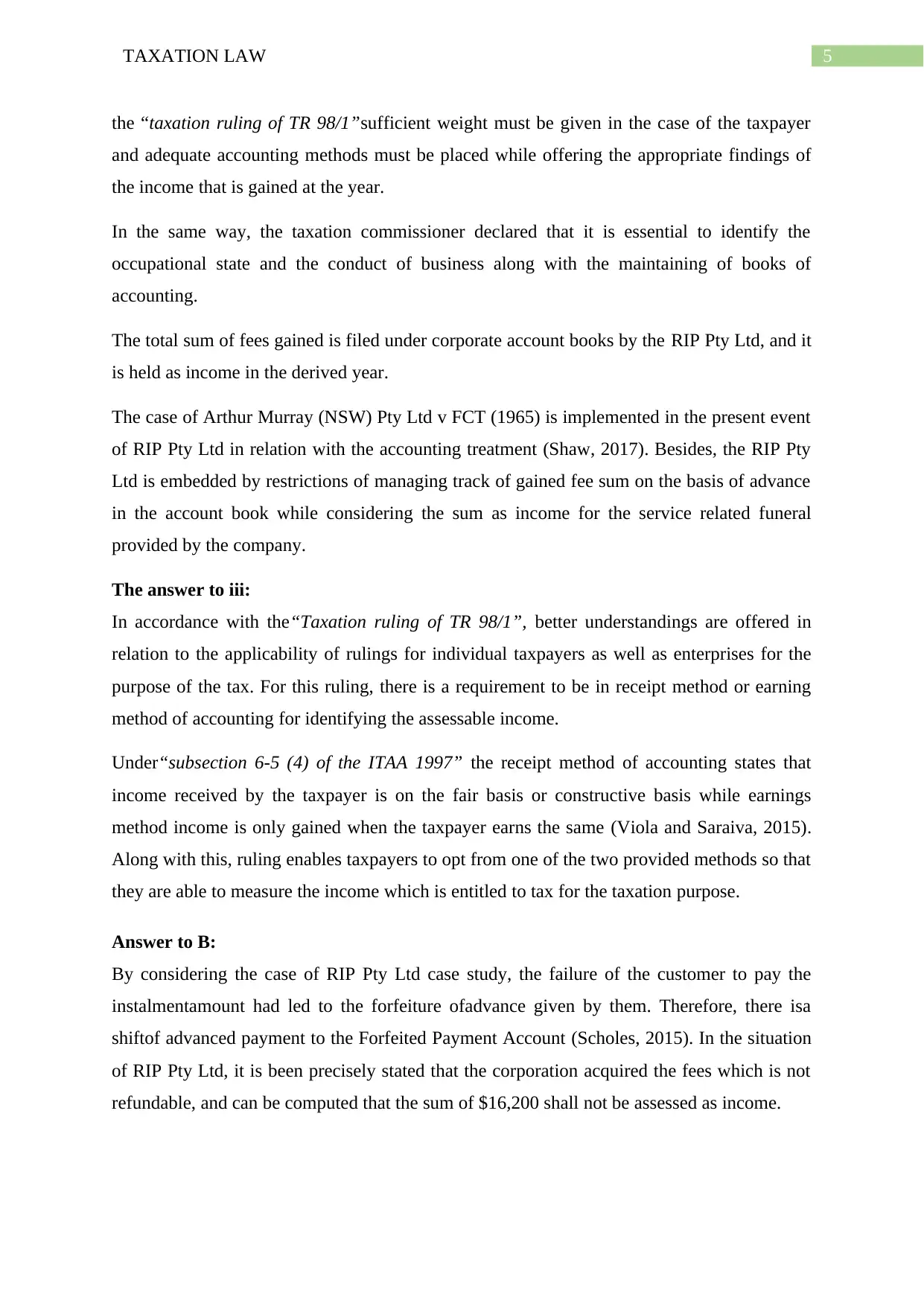
5TAXATION LAW
the “taxation ruling of TR 98/1”sufficient weight must be given in the case of the taxpayer
and adequate accounting methods must be placed while offering the appropriate findings of
the income that is gained at the year.
In the same way, the taxation commissioner declared that it is essential to identify the
occupational state and the conduct of business along with the maintaining of books of
accounting.
The total sum of fees gained is filed under corporate account books by the RIP Pty Ltd, and it
is held as income in the derived year.
The case of Arthur Murray (NSW) Pty Ltd v FCT (1965) is implemented in the present event
of RIP Pty Ltd in relation with the accounting treatment (Shaw, 2017). Besides, the RIP Pty
Ltd is embedded by restrictions of managing track of gained fee sum on the basis of advance
in the account book while considering the sum as income for the service related funeral
provided by the company.
The answer to iii:
In accordance with the“Taxation ruling of TR 98/1”, better understandings are offered in
relation to the applicability of rulings for individual taxpayers as well as enterprises for the
purpose of the tax. For this ruling, there is a requirement to be in receipt method or earning
method of accounting for identifying the assessable income.
Under“subsection 6-5 (4) of the ITAA 1997” the receipt method of accounting states that
income received by the taxpayer is on the fair basis or constructive basis while earnings
method income is only gained when the taxpayer earns the same (Viola and Saraiva, 2015).
Along with this, ruling enables taxpayers to opt from one of the two provided methods so that
they are able to measure the income which is entitled to tax for the taxation purpose.
Answer to B:
By considering the case of RIP Pty Ltd case study, the failure of the customer to pay the
instalmentamount had led to the forfeiture ofadvance given by them. Therefore, there isa
shiftof advanced payment to the Forfeited Payment Account (Scholes, 2015). In the situation
of RIP Pty Ltd, it is been precisely stated that the corporation acquired the fees which is not
refundable, and can be computed that the sum of $16,200 shall not be assessed as income.
the “taxation ruling of TR 98/1”sufficient weight must be given in the case of the taxpayer
and adequate accounting methods must be placed while offering the appropriate findings of
the income that is gained at the year.
In the same way, the taxation commissioner declared that it is essential to identify the
occupational state and the conduct of business along with the maintaining of books of
accounting.
The total sum of fees gained is filed under corporate account books by the RIP Pty Ltd, and it
is held as income in the derived year.
The case of Arthur Murray (NSW) Pty Ltd v FCT (1965) is implemented in the present event
of RIP Pty Ltd in relation with the accounting treatment (Shaw, 2017). Besides, the RIP Pty
Ltd is embedded by restrictions of managing track of gained fee sum on the basis of advance
in the account book while considering the sum as income for the service related funeral
provided by the company.
The answer to iii:
In accordance with the“Taxation ruling of TR 98/1”, better understandings are offered in
relation to the applicability of rulings for individual taxpayers as well as enterprises for the
purpose of the tax. For this ruling, there is a requirement to be in receipt method or earning
method of accounting for identifying the assessable income.
Under“subsection 6-5 (4) of the ITAA 1997” the receipt method of accounting states that
income received by the taxpayer is on the fair basis or constructive basis while earnings
method income is only gained when the taxpayer earns the same (Viola and Saraiva, 2015).
Along with this, ruling enables taxpayers to opt from one of the two provided methods so that
they are able to measure the income which is entitled to tax for the taxation purpose.
Answer to B:
By considering the case of RIP Pty Ltd case study, the failure of the customer to pay the
instalmentamount had led to the forfeiture ofadvance given by them. Therefore, there isa
shiftof advanced payment to the Forfeited Payment Account (Scholes, 2015). In the situation
of RIP Pty Ltd, it is been precisely stated that the corporation acquired the fees which is not
refundable, and can be computed that the sum of $16,200 shall not be assessed as income.
⊘ This is a preview!⊘
Do you want full access?
Subscribe today to unlock all pages.

Trusted by 1+ million students worldwide

6TAXATION LAW
Answer to Part B:
Answerto A:
Provided under section 70-10 of the ITAA 1997, trading inventory given to the manufactured
products in a business course, which would be found with the purpose of putting the same
into sale in the market. On the other hand, section 70-25 of the ITAA 1997 explains that the
expenses which are incurred during the demeanour of trading inventory should be based on
the nature of capital.
Under“section 275-105 of the ITAA 1997”, CGT assets are not considered by trading assets,
as the sections do not cover the same (Nechaev and Antipina, 2016). taking the case of RIP
Pty Ltd into account, the caskets as well as the accessories bought in the ordinary business
course would be amended as trading inventory and the same will not be considered for the
purpose of capital assets.
The definition provided by the “section 8-1 of the ITAA 1997”expenses that an individual or
entity incurs while purchasing trading stock isstated as an allowed deduction.By considering
the case of RIP Pty Ltd the accessories and caskets purchased in the regular course of
business will be referred as the permissible deductions. Moreover, claim deductions are also
obliged to RIP Pty Ltd for the trading stock item be purchased at the regular business course
and the inventory that is retained as closing stock in hand.
The affirmative aspect of “section 8-1 of the ITAA 1997” enables an individual from their
assessable income for claim deduction regarding the incurred amount while generating
taxpayer’s taxable income(Cooper and et al., 2016). As shown in the case of RIP Pty Ltd, the
sum of prepaid expense been incurred while purchasing trading stock will be entitled as
allowable deductions as per “section 8-1 of the ITAA 1997”, as it was regarded to the taxable
income derivation. Further, the prepaid sum would be referred as the amount paid in advance
at the year ended 2016.
Answer to B:
As the definition provided under “section 6-5 of the ITAA 1997’ a person deriving income
from the regular sources is applicable for assessment on the basis of general concepts. As per
the ATO, a resident company based in Australia that gains dividend from the sources of
Answer to Part B:
Answerto A:
Provided under section 70-10 of the ITAA 1997, trading inventory given to the manufactured
products in a business course, which would be found with the purpose of putting the same
into sale in the market. On the other hand, section 70-25 of the ITAA 1997 explains that the
expenses which are incurred during the demeanour of trading inventory should be based on
the nature of capital.
Under“section 275-105 of the ITAA 1997”, CGT assets are not considered by trading assets,
as the sections do not cover the same (Nechaev and Antipina, 2016). taking the case of RIP
Pty Ltd into account, the caskets as well as the accessories bought in the ordinary business
course would be amended as trading inventory and the same will not be considered for the
purpose of capital assets.
The definition provided by the “section 8-1 of the ITAA 1997”expenses that an individual or
entity incurs while purchasing trading stock isstated as an allowed deduction.By considering
the case of RIP Pty Ltd the accessories and caskets purchased in the regular course of
business will be referred as the permissible deductions. Moreover, claim deductions are also
obliged to RIP Pty Ltd for the trading stock item be purchased at the regular business course
and the inventory that is retained as closing stock in hand.
The affirmative aspect of “section 8-1 of the ITAA 1997” enables an individual from their
assessable income for claim deduction regarding the incurred amount while generating
taxpayer’s taxable income(Cooper and et al., 2016). As shown in the case of RIP Pty Ltd, the
sum of prepaid expense been incurred while purchasing trading stock will be entitled as
allowable deductions as per “section 8-1 of the ITAA 1997”, as it was regarded to the taxable
income derivation. Further, the prepaid sum would be referred as the amount paid in advance
at the year ended 2016.
Answer to B:
As the definition provided under “section 6-5 of the ITAA 1997’ a person deriving income
from the regular sources is applicable for assessment on the basis of general concepts. As per
the ATO, a resident company based in Australia that gains dividend from the sources of
Paraphrase This Document
Need a fresh take? Get an instant paraphrase of this document with our AI Paraphraser
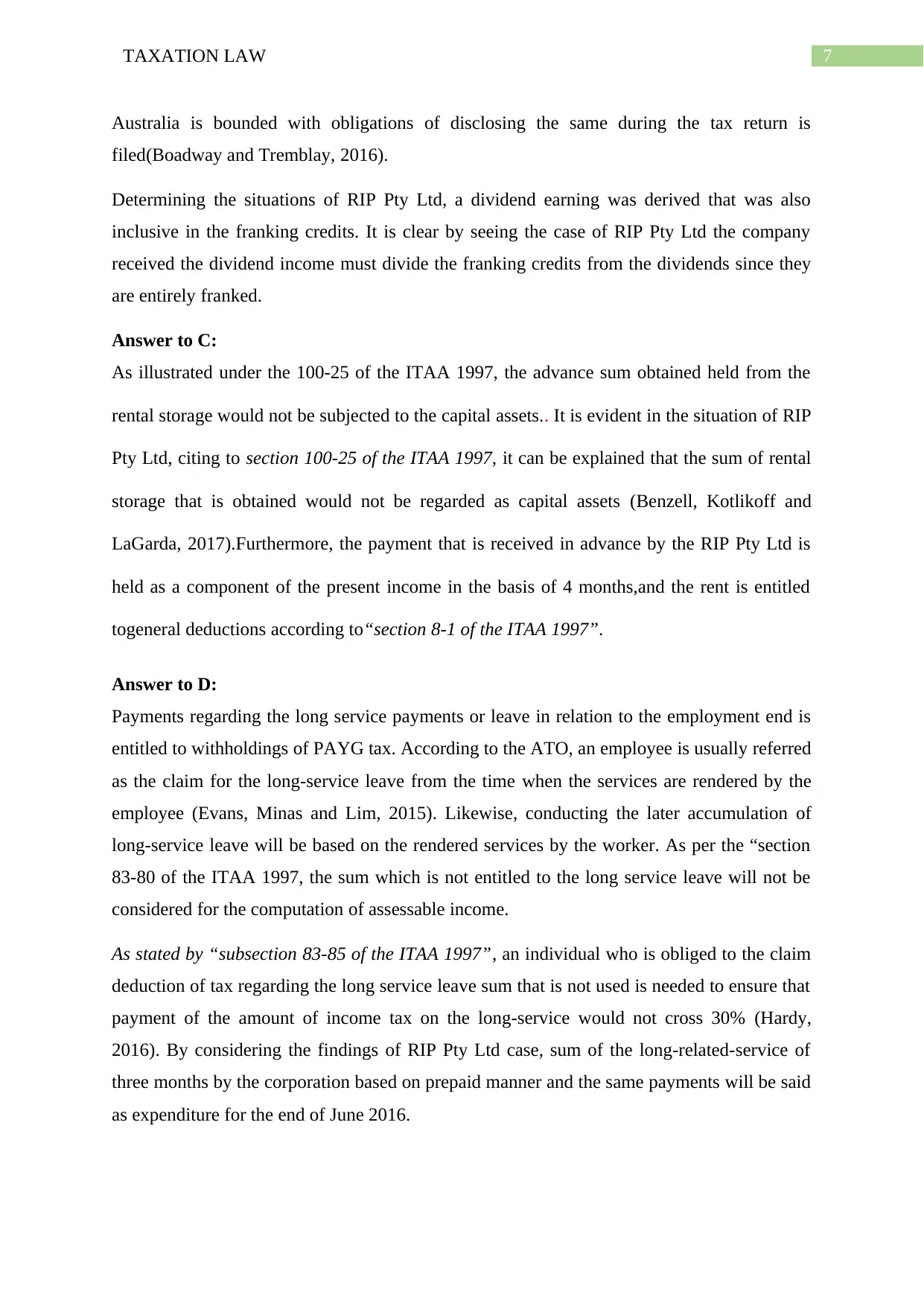
7TAXATION LAW
Australia is bounded with obligations of disclosing the same during the tax return is
filed(Boadway and Tremblay, 2016).
Determining the situations of RIP Pty Ltd, a dividend earning was derived that was also
inclusive in the franking credits. It is clear by seeing the case of RIP Pty Ltd the company
received the dividend income must divide the franking credits from the dividends since they
are entirely franked.
Answer to C:
As illustrated under the 100-25 of the ITAA 1997, the advance sum obtained held from the
rental storage would not be subjected to the capital assets.. It is evident in the situation of RIP
Pty Ltd, citing to section 100-25 of the ITAA 1997, it can be explained that the sum of rental
storage that is obtained would not be regarded as capital assets (Benzell, Kotlikoff and
LaGarda, 2017).Furthermore, the payment that is received in advance by the RIP Pty Ltd is
held as a component of the present income in the basis of 4 months,and the rent is entitled
togeneral deductions according to“section 8-1 of the ITAA 1997”.
Answer to D:
Payments regarding the long service payments or leave in relation to the employment end is
entitled to withholdings of PAYG tax. According to the ATO, an employee is usually referred
as the claim for the long-service leave from the time when the services are rendered by the
employee (Evans, Minas and Lim, 2015). Likewise, conducting the later accumulation of
long-service leave will be based on the rendered services by the worker. As per the “section
83-80 of the ITAA 1997, the sum which is not entitled to the long service leave will not be
considered for the computation of assessable income.
As stated by “subsection 83-85 of the ITAA 1997”, an individual who is obliged to the claim
deduction of tax regarding the long service leave sum that is not used is needed to ensure that
payment of the amount of income tax on the long-service would not cross 30% (Hardy,
2016). By considering the findings of RIP Pty Ltd case, sum of the long-related-service of
three months by the corporation based on prepaid manner and the same payments will be said
as expenditure for the end of June 2016.
Australia is bounded with obligations of disclosing the same during the tax return is
filed(Boadway and Tremblay, 2016).
Determining the situations of RIP Pty Ltd, a dividend earning was derived that was also
inclusive in the franking credits. It is clear by seeing the case of RIP Pty Ltd the company
received the dividend income must divide the franking credits from the dividends since they
are entirely franked.
Answer to C:
As illustrated under the 100-25 of the ITAA 1997, the advance sum obtained held from the
rental storage would not be subjected to the capital assets.. It is evident in the situation of RIP
Pty Ltd, citing to section 100-25 of the ITAA 1997, it can be explained that the sum of rental
storage that is obtained would not be regarded as capital assets (Benzell, Kotlikoff and
LaGarda, 2017).Furthermore, the payment that is received in advance by the RIP Pty Ltd is
held as a component of the present income in the basis of 4 months,and the rent is entitled
togeneral deductions according to“section 8-1 of the ITAA 1997”.
Answer to D:
Payments regarding the long service payments or leave in relation to the employment end is
entitled to withholdings of PAYG tax. According to the ATO, an employee is usually referred
as the claim for the long-service leave from the time when the services are rendered by the
employee (Evans, Minas and Lim, 2015). Likewise, conducting the later accumulation of
long-service leave will be based on the rendered services by the worker. As per the “section
83-80 of the ITAA 1997, the sum which is not entitled to the long service leave will not be
considered for the computation of assessable income.
As stated by “subsection 83-85 of the ITAA 1997”, an individual who is obliged to the claim
deduction of tax regarding the long service leave sum that is not used is needed to ensure that
payment of the amount of income tax on the long-service would not cross 30% (Hardy,
2016). By considering the findings of RIP Pty Ltd case, sum of the long-related-service of
three months by the corporation based on prepaid manner and the same payments will be said
as expenditure for the end of June 2016.
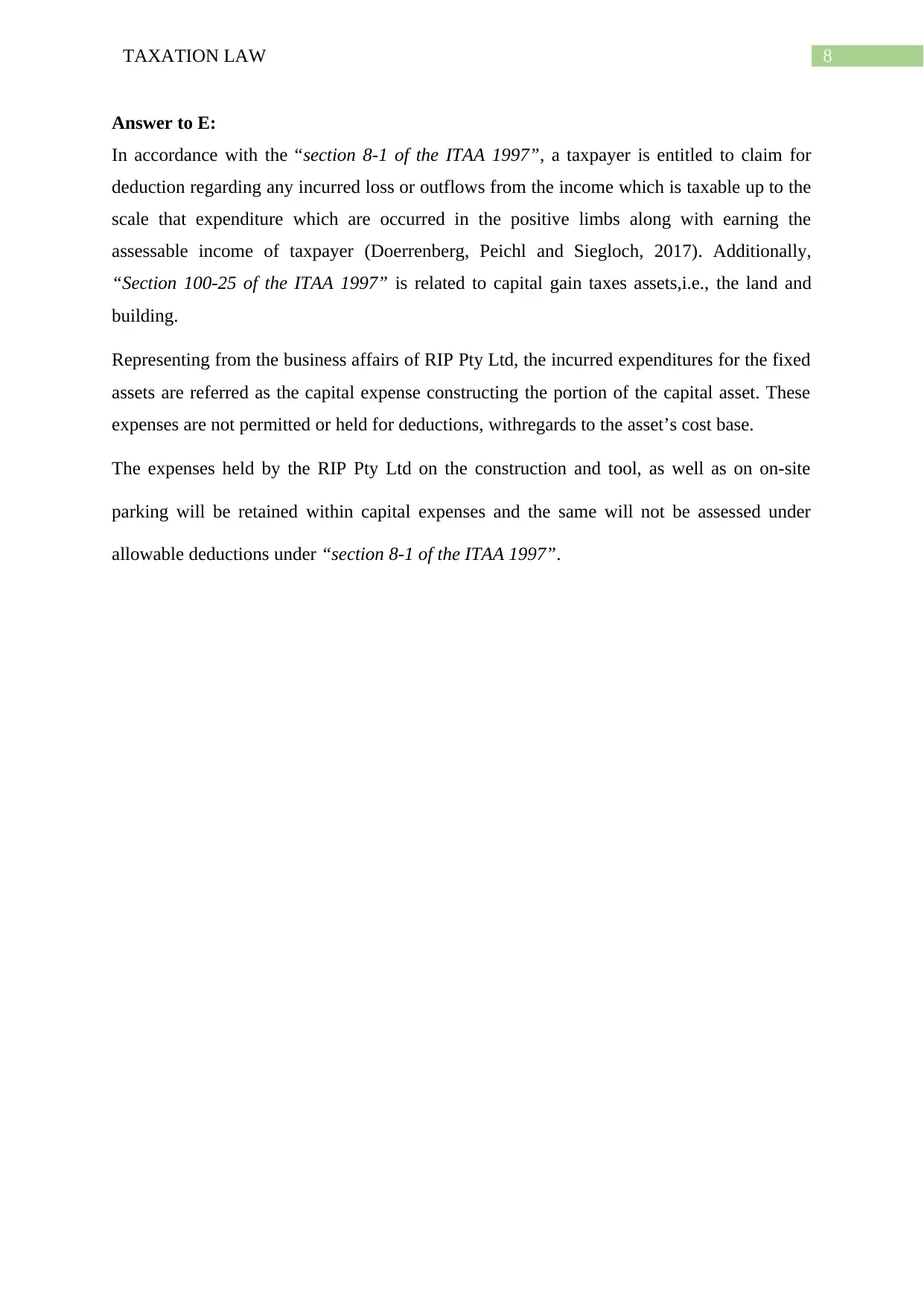
8TAXATION LAW
Answer to E:
In accordance with the “section 8-1 of the ITAA 1997”, a taxpayer is entitled to claim for
deduction regarding any incurred loss or outflows from the income which is taxable up to the
scale that expenditure which are occurred in the positive limbs along with earning the
assessable income of taxpayer (Doerrenberg, Peichl and Siegloch, 2017). Additionally,
“Section 100-25 of the ITAA 1997” is related to capital gain taxes assets,i.e., the land and
building.
Representing from the business affairs of RIP Pty Ltd, the incurred expenditures for the fixed
assets are referred as the capital expense constructing the portion of the capital asset. These
expenses are not permitted or held for deductions, withregards to the asset’s cost base.
The expenses held by the RIP Pty Ltd on the construction and tool, as well as on on-site
parking will be retained within capital expenses and the same will not be assessed under
allowable deductions under “section 8-1 of the ITAA 1997”.
Answer to E:
In accordance with the “section 8-1 of the ITAA 1997”, a taxpayer is entitled to claim for
deduction regarding any incurred loss or outflows from the income which is taxable up to the
scale that expenditure which are occurred in the positive limbs along with earning the
assessable income of taxpayer (Doerrenberg, Peichl and Siegloch, 2017). Additionally,
“Section 100-25 of the ITAA 1997” is related to capital gain taxes assets,i.e., the land and
building.
Representing from the business affairs of RIP Pty Ltd, the incurred expenditures for the fixed
assets are referred as the capital expense constructing the portion of the capital asset. These
expenses are not permitted or held for deductions, withregards to the asset’s cost base.
The expenses held by the RIP Pty Ltd on the construction and tool, as well as on on-site
parking will be retained within capital expenses and the same will not be assessed under
allowable deductions under “section 8-1 of the ITAA 1997”.
⊘ This is a preview!⊘
Do you want full access?
Subscribe today to unlock all pages.

Trusted by 1+ million students worldwide
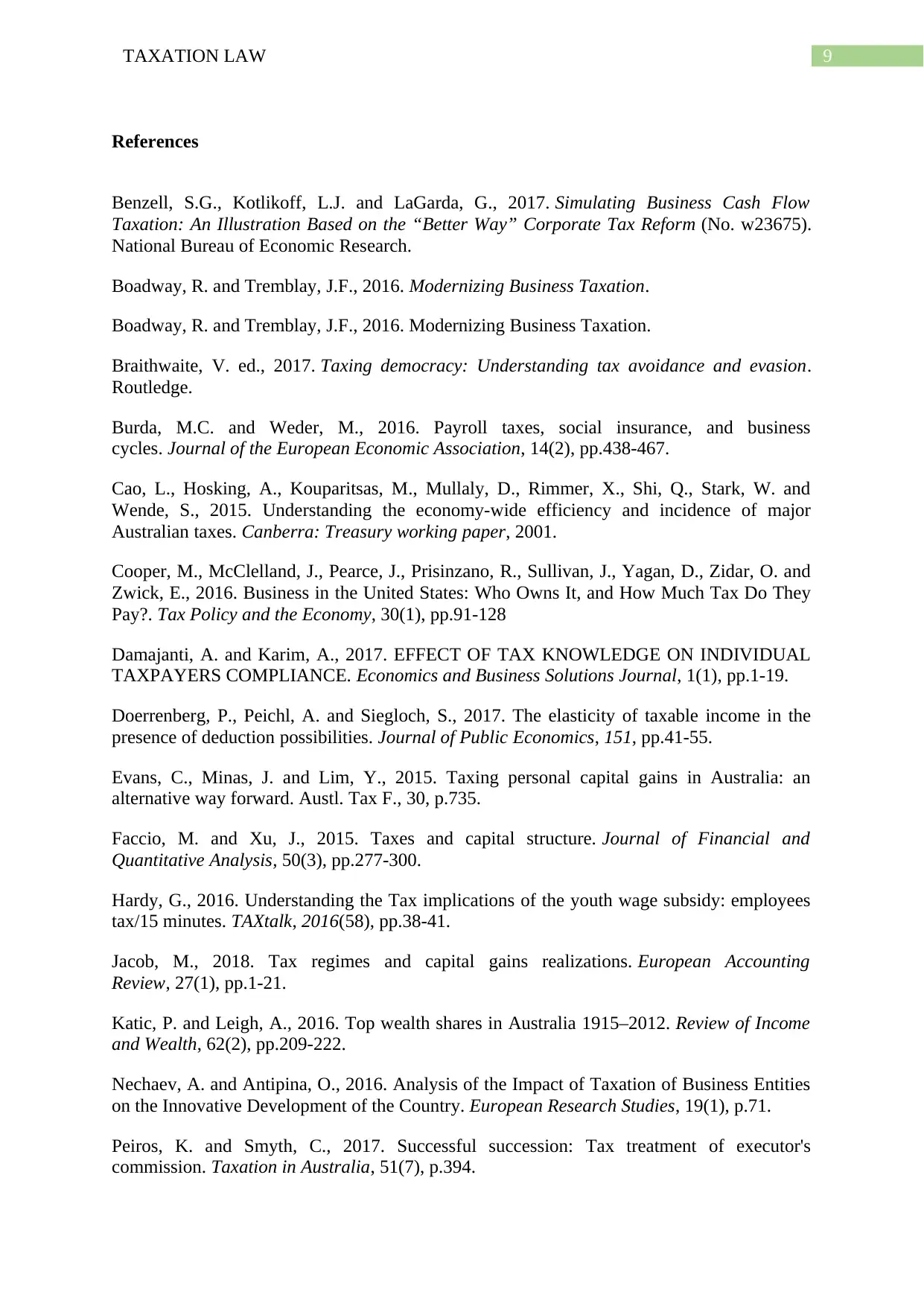
9TAXATION LAW
References
Benzell, S.G., Kotlikoff, L.J. and LaGarda, G., 2017. Simulating Business Cash Flow
Taxation: An Illustration Based on the “Better Way” Corporate Tax Reform (No. w23675).
National Bureau of Economic Research.
Boadway, R. and Tremblay, J.F., 2016. Modernizing Business Taxation.
Boadway, R. and Tremblay, J.F., 2016. Modernizing Business Taxation.
Braithwaite, V. ed., 2017. Taxing democracy: Understanding tax avoidance and evasion.
Routledge.
Burda, M.C. and Weder, M., 2016. Payroll taxes, social insurance, and business
cycles. Journal of the European Economic Association, 14(2), pp.438-467.
Cao, L., Hosking, A., Kouparitsas, M., Mullaly, D., Rimmer, X., Shi, Q., Stark, W. and
Wende, S., 2015. Understanding the economy-wide efficiency and incidence of major
Australian taxes. Canberra: Treasury working paper, 2001.
Cooper, M., McClelland, J., Pearce, J., Prisinzano, R., Sullivan, J., Yagan, D., Zidar, O. and
Zwick, E., 2016. Business in the United States: Who Owns It, and How Much Tax Do They
Pay?. Tax Policy and the Economy, 30(1), pp.91-128
Damajanti, A. and Karim, A., 2017. EFFECT OF TAX KNOWLEDGE ON INDIVIDUAL
TAXPAYERS COMPLIANCE. Economics and Business Solutions Journal, 1(1), pp.1-19.
Doerrenberg, P., Peichl, A. and Siegloch, S., 2017. The elasticity of taxable income in the
presence of deduction possibilities. Journal of Public Economics, 151, pp.41-55.
Evans, C., Minas, J. and Lim, Y., 2015. Taxing personal capital gains in Australia: an
alternative way forward. Austl. Tax F., 30, p.735.
Faccio, M. and Xu, J., 2015. Taxes and capital structure. Journal of Financial and
Quantitative Analysis, 50(3), pp.277-300.
Hardy, G., 2016. Understanding the Tax implications of the youth wage subsidy: employees
tax/15 minutes. TAXtalk, 2016(58), pp.38-41.
Jacob, M., 2018. Tax regimes and capital gains realizations. European Accounting
Review, 27(1), pp.1-21.
Katic, P. and Leigh, A., 2016. Top wealth shares in Australia 1915–2012. Review of Income
and Wealth, 62(2), pp.209-222.
Nechaev, A. and Antipina, O., 2016. Analysis of the Impact of Taxation of Business Entities
on the Innovative Development of the Country. European Research Studies, 19(1), p.71.
Peiros, K. and Smyth, C., 2017. Successful succession: Tax treatment of executor's
commission. Taxation in Australia, 51(7), p.394.
References
Benzell, S.G., Kotlikoff, L.J. and LaGarda, G., 2017. Simulating Business Cash Flow
Taxation: An Illustration Based on the “Better Way” Corporate Tax Reform (No. w23675).
National Bureau of Economic Research.
Boadway, R. and Tremblay, J.F., 2016. Modernizing Business Taxation.
Boadway, R. and Tremblay, J.F., 2016. Modernizing Business Taxation.
Braithwaite, V. ed., 2017. Taxing democracy: Understanding tax avoidance and evasion.
Routledge.
Burda, M.C. and Weder, M., 2016. Payroll taxes, social insurance, and business
cycles. Journal of the European Economic Association, 14(2), pp.438-467.
Cao, L., Hosking, A., Kouparitsas, M., Mullaly, D., Rimmer, X., Shi, Q., Stark, W. and
Wende, S., 2015. Understanding the economy-wide efficiency and incidence of major
Australian taxes. Canberra: Treasury working paper, 2001.
Cooper, M., McClelland, J., Pearce, J., Prisinzano, R., Sullivan, J., Yagan, D., Zidar, O. and
Zwick, E., 2016. Business in the United States: Who Owns It, and How Much Tax Do They
Pay?. Tax Policy and the Economy, 30(1), pp.91-128
Damajanti, A. and Karim, A., 2017. EFFECT OF TAX KNOWLEDGE ON INDIVIDUAL
TAXPAYERS COMPLIANCE. Economics and Business Solutions Journal, 1(1), pp.1-19.
Doerrenberg, P., Peichl, A. and Siegloch, S., 2017. The elasticity of taxable income in the
presence of deduction possibilities. Journal of Public Economics, 151, pp.41-55.
Evans, C., Minas, J. and Lim, Y., 2015. Taxing personal capital gains in Australia: an
alternative way forward. Austl. Tax F., 30, p.735.
Faccio, M. and Xu, J., 2015. Taxes and capital structure. Journal of Financial and
Quantitative Analysis, 50(3), pp.277-300.
Hardy, G., 2016. Understanding the Tax implications of the youth wage subsidy: employees
tax/15 minutes. TAXtalk, 2016(58), pp.38-41.
Jacob, M., 2018. Tax regimes and capital gains realizations. European Accounting
Review, 27(1), pp.1-21.
Katic, P. and Leigh, A., 2016. Top wealth shares in Australia 1915–2012. Review of Income
and Wealth, 62(2), pp.209-222.
Nechaev, A. and Antipina, O., 2016. Analysis of the Impact of Taxation of Business Entities
on the Innovative Development of the Country. European Research Studies, 19(1), p.71.
Peiros, K. and Smyth, C., 2017. Successful succession: Tax treatment of executor's
commission. Taxation in Australia, 51(7), p.394.
Paraphrase This Document
Need a fresh take? Get an instant paraphrase of this document with our AI Paraphraser
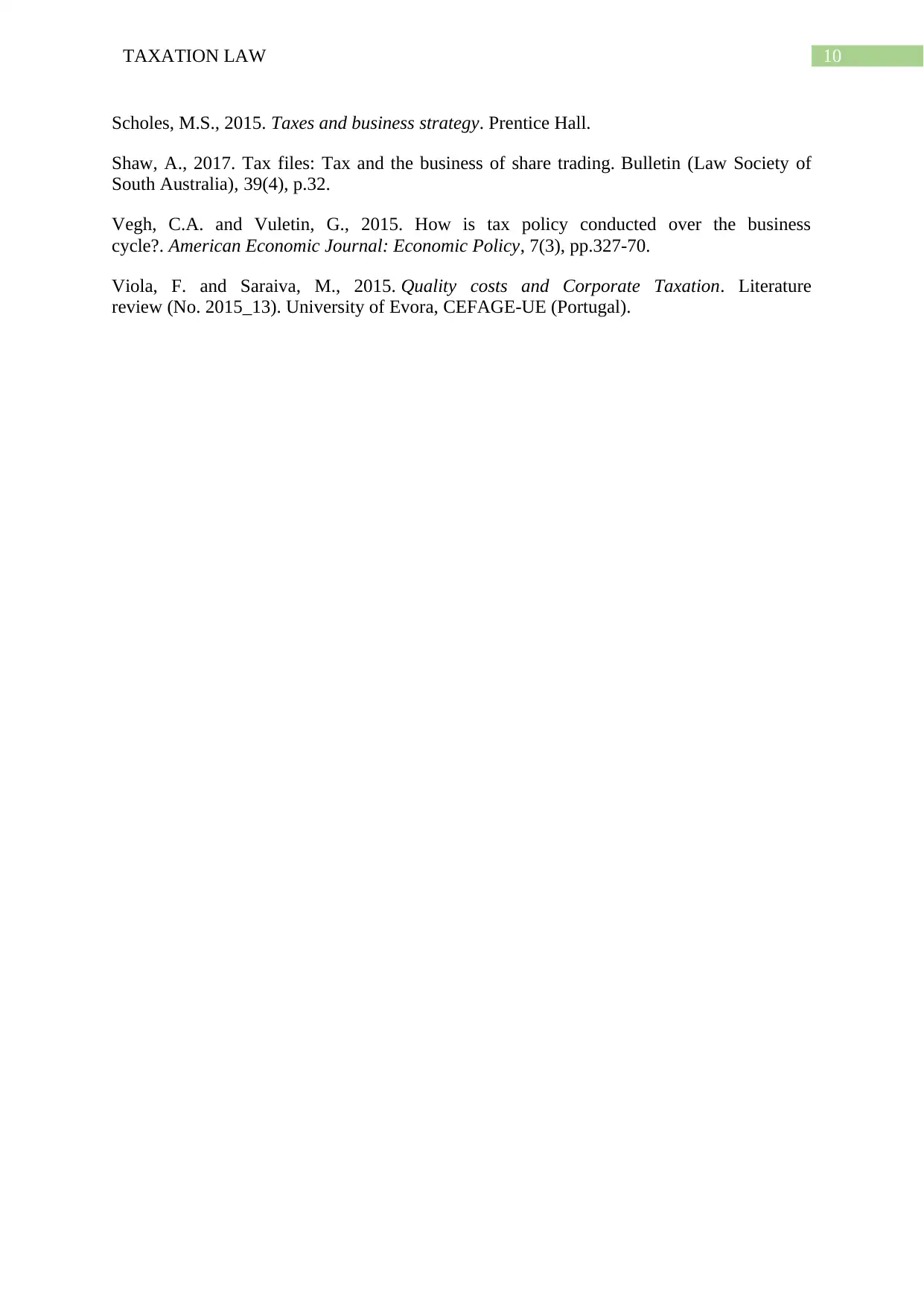
10TAXATION LAW
Scholes, M.S., 2015. Taxes and business strategy. Prentice Hall.
Shaw, A., 2017. Tax files: Tax and the business of share trading. Bulletin (Law Society of
South Australia), 39(4), p.32.
Vegh, C.A. and Vuletin, G., 2015. How is tax policy conducted over the business
cycle?. American Economic Journal: Economic Policy, 7(3), pp.327-70.
Viola, F. and Saraiva, M., 2015. Quality costs and Corporate Taxation. Literature
review (No. 2015_13). University of Evora, CEFAGE-UE (Portugal).
Scholes, M.S., 2015. Taxes and business strategy. Prentice Hall.
Shaw, A., 2017. Tax files: Tax and the business of share trading. Bulletin (Law Society of
South Australia), 39(4), p.32.
Vegh, C.A. and Vuletin, G., 2015. How is tax policy conducted over the business
cycle?. American Economic Journal: Economic Policy, 7(3), pp.327-70.
Viola, F. and Saraiva, M., 2015. Quality costs and Corporate Taxation. Literature
review (No. 2015_13). University of Evora, CEFAGE-UE (Portugal).
1 out of 11
Related Documents
Your All-in-One AI-Powered Toolkit for Academic Success.
+13062052269
info@desklib.com
Available 24*7 on WhatsApp / Email
![[object Object]](/_next/static/media/star-bottom.7253800d.svg)
Unlock your academic potential
Copyright © 2020–2025 A2Z Services. All Rights Reserved. Developed and managed by ZUCOL.





